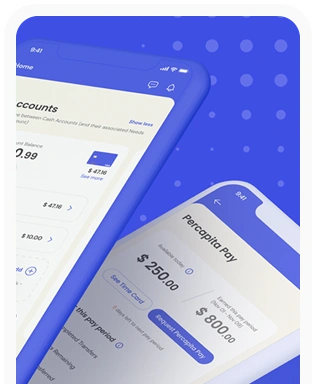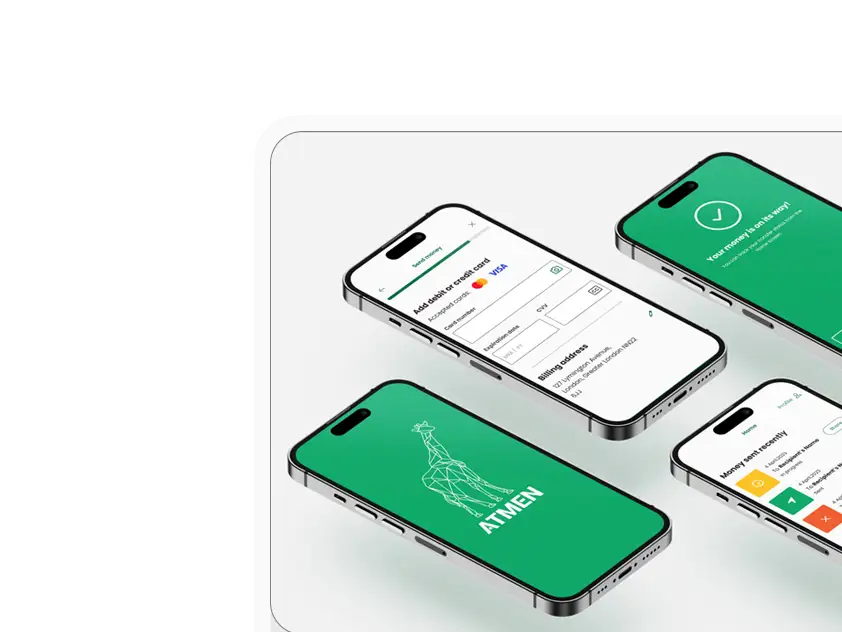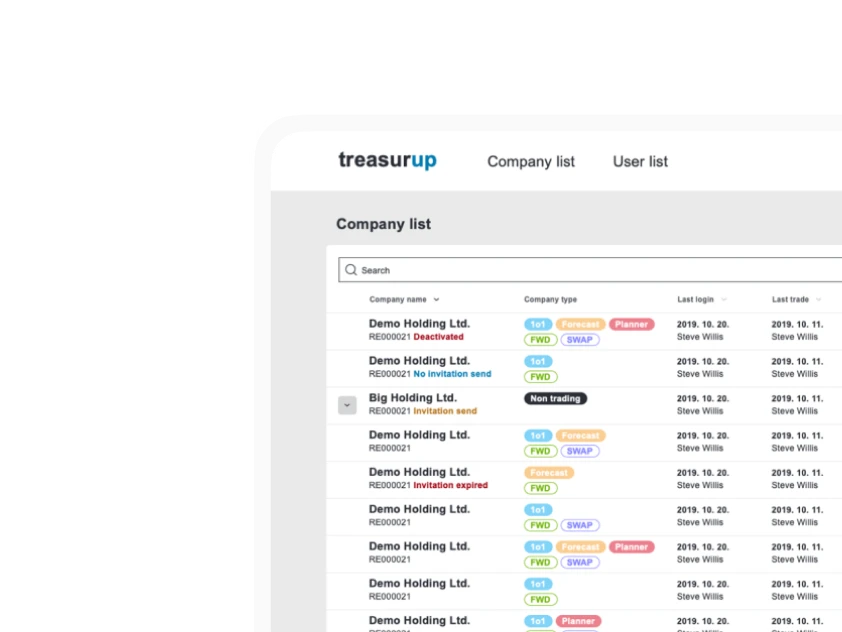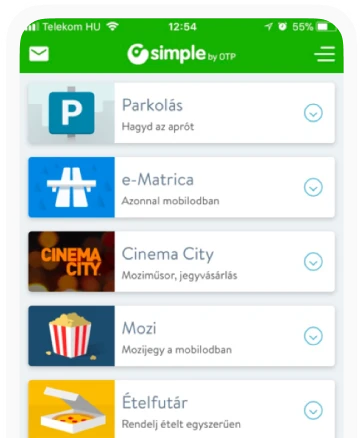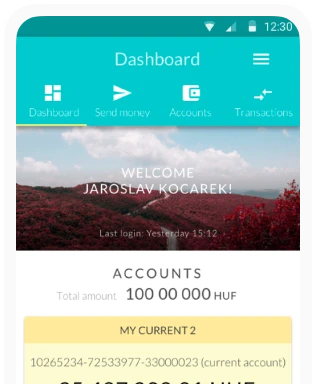Business Model Canvas: Complete business model on a single sheet of paper
Many years ago business plans were documents that spanned tens of pages. They were later cut down to 3-5 pages. But as our environment changes- so does the business environment. Startups come and go, they may or may not survive one year, so the business plans also have to be revamped. Because something that we can imagine today and describe in a detailed 30 page document may change in three months’ time due to our fast-changing business environment.
This is why the Business Model Canvas based on research by Swiss economist Alex Osterwalder and co-created by 470 “Business Model Canvas” practitioners from 45 countries became so popular. The main concept is to display, elaborate and visualize the operation of the entire business on a single sheet, a clear-cut “canvas”.
The Business Model Canvas models the components of the envisaged business in nine different areas. Everything is in one place, formulated in concise sentences. We can easily visualize the operability of the business and immediately notice strategic and other flaws. And if the business environment or other factors change significantly from the perspective of the business, the Canvas can be easily redesigned. This is a huge advantage in today’s ever-shifting market environment.
The Canvas is somewhere between a concept sketched on a napkin and a 30-page business plan. It is not intended to replace either one, but is instead an interim step. Although it could be omitted, it is highly recommended as it holds the specific details that can reveal far more than a sketch, yet is simple to review and can be created faster than a full-fledged business plan, which serves a different function.
We discuss and review 9 parts of the business plan on the canvas based on:
Our value proposition is located in the centre of the “original” model, the most important part, where we clarify the issues faced by the customer that need to be resolved and the needs we intend to satisfy. To the right are the three areas characterizing our buyers and customers (customer relationships, customer segments and channels) and on the other side we list the key activities required for executing our idea, as well as key resources and key partners. The two lower parts of the model show the financial aspects of the business (cost structure and revenue streams). You can access the original Canvas here: strategyzer.com
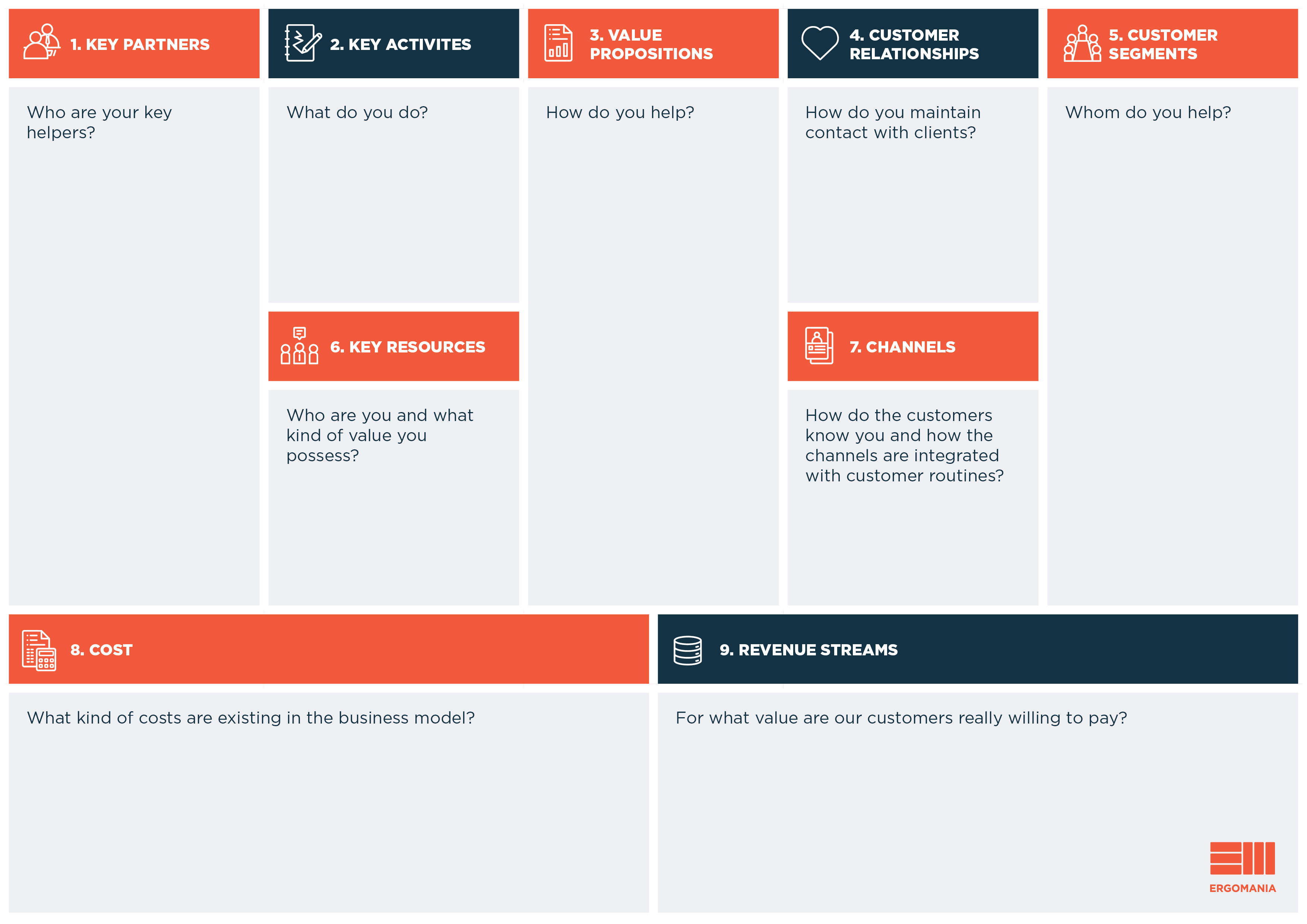
Because the Canvas is publicly available under the Creative Commons license, it was further developed by many people in many different ways. We at Ergomania have already tried to create a Business Model Canvas on the occasion for an earlier workshop where we worked with a modified version of the original canvas designed by Strategyzer.com. We used a version more aligned to the Service-dominant logic and the Service Management model which differs slightly from the original. The basic principle is the same, but the fields are somewhat different and therefore the logic for completing the fields is also different. Namely, whether we focus on creating something or on creating value together with the customer makes a difference. So the focus changes in function of our approach. This is why “value creation” was placed at the centre in our version.
Here, we discuss the application of the Business Model Canvas with the help of the model we used.
This is the Canvas we used:

The order in which we fill out the canvas is paramount. The thought process always starts with the customer and progresses according to the sequence of the numbers. Below we explain the contents of the Canvas based on the blocks.
In the first block on the right side, we discussed the topics that can bring us money.
1. Customer/target group/partner
We start the process by getting to know the customer: we should first define who our products or services may attract. We should think long about who customers are and which needs we need to satisfy. Who should we partner with? For this, it is vital to thoroughly familiarize ourselves with our customers’ lifestyle: why they buy certain things and what benefits they expect.
Think about paying and non-paying customers and users. Also consider who could be the “early adopters”, i.e., the first ones to use our product and who will hopefully get the word out about it. Also consider the kind of issues and needs we want to respond to.
Our marketing approach can be mentioned here: who needs our solution at all? How many people like this are there?
2. Customer value and value proposition
Reflect on the real value of our service for the customer. This will be our offer.
What is the value, what do we actually sell? What solution do we offer for what type of problem? How does our offer fit into the customer’s world, how can we help our customer to achieve her goals? Then find the solution for each issue that was mapped.
Also reflect on the components of the offer and how it is unique. How long will all of this take? Which part of it will be free (if any) and which part will cost money? How much will it cost? From the client’s perspective: what customer problem can our solution solve?
When identifying the issues, it is worthwhile to explore the underlying causes.
4. Customer relationships, channels, interactions and cooperation.
How can we support cooperation and interaction with the customer?
Where are our customers and how can we reach them? What kind of interactions can be expected during which value will be created for the customer?
How do we talk about our solution? How and through which channel can we get our messages to the target group?
In the centre of the canvas we put:
3. Our key activity, i.e. value creation, which is essentially our mission
Based on Service Dominant Logic (SDL), value creation can only happen together with the customer, with his active cooperation. So think about and describe not only what you have to do to produce the product or service, but also how the value is created for the customer while using the product/service.
Here we can describe and list the processes needed to achieve our objective, the activities needed to create value.
The components that cost money are placed on the left side of the Canvas:
6. Key Resources
What skills and knowledge do we need to perform the activities listed in block no. 3 (key activities, value creation, essentially our mission) so that the values listed in block no. 2 (customer value and value proposition) can be manifested?
What other financial and non-financial resources and tools are needed for actually providing the customer the value formulated in our value proposition? Consider what skills and knowledge customers need and what financial and nonfinancial resources may be needed from the customer.
7. Key partners:
Who are our key partners? What is their role? What resources are needed from partners? What benefits will they get from cooperating with us?
What experiences do customers have with partners?
8. Involving resources and partners
How should we coordinate value creation involving several participants? How can we utilize and develop partners and resources?
How can customers actually benefit from these?
The strict financial aspects will be placed at the bottom of the Canvas.
5. Income-revenue structure: revenue streams and indicators will be listed here
Looking at it from the service provider perspective, it is worthwhile to reflect on our revenue logic, how financial feedback works. Nonfinancial values and business success indicators can also be listed here.
Also reflect on/become familiar with the kind of values that the customer is willing to pay for and the possible financial benefits for the customer.
9. Cost structure
Reflect on all those aspects that relate to the expenses of the business model, any auxiliary costs and any other sacrifice. Do the same from the perspective of the service provider and the customer.
Additional information: Considering the changing values of our era (environmental awareness, the rise of sustainability and social responsibility in consumer and customer decisions) so in the last block (revenue and cost structure), think about the impacts that cannot be measured directly in terms of money but which may supplement the business by considering other “higher” aspects and the perception thereof.
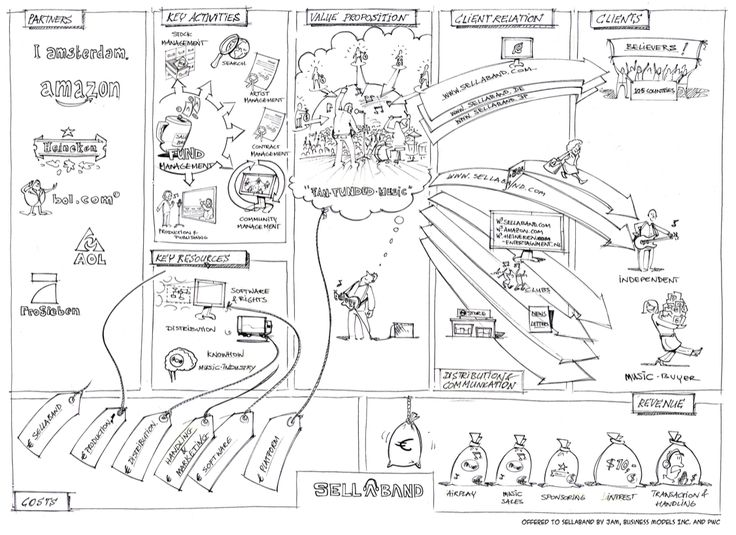
If we build our business model thinking within this framework, we may have to rewrite it several times, but the end result will be a functional business model, at least on paper. The simplest way of developing the model is by printing out the Canvas in a very large size, sitting around it and filling it with contents while brainstorming.
Those who prefer to work online can visit: canvanizer.com orstrategyzer.com.
You can fill in the Business Model Canvas either alone or together with coworkers, but the greatest benefit can be drawn if we reflect on the various components as part of a professional workshop led by an expert. This is what we did at Ergomania when we developed the Business Model Canvas for one of our customers as part of the above-mentioned workshop. And what an amazing success it was! Led by Zoltán Dévai Senior Service Design advisor, using the LE GO Serious Play methodology, we just played seriously. See our earlier post on this here.
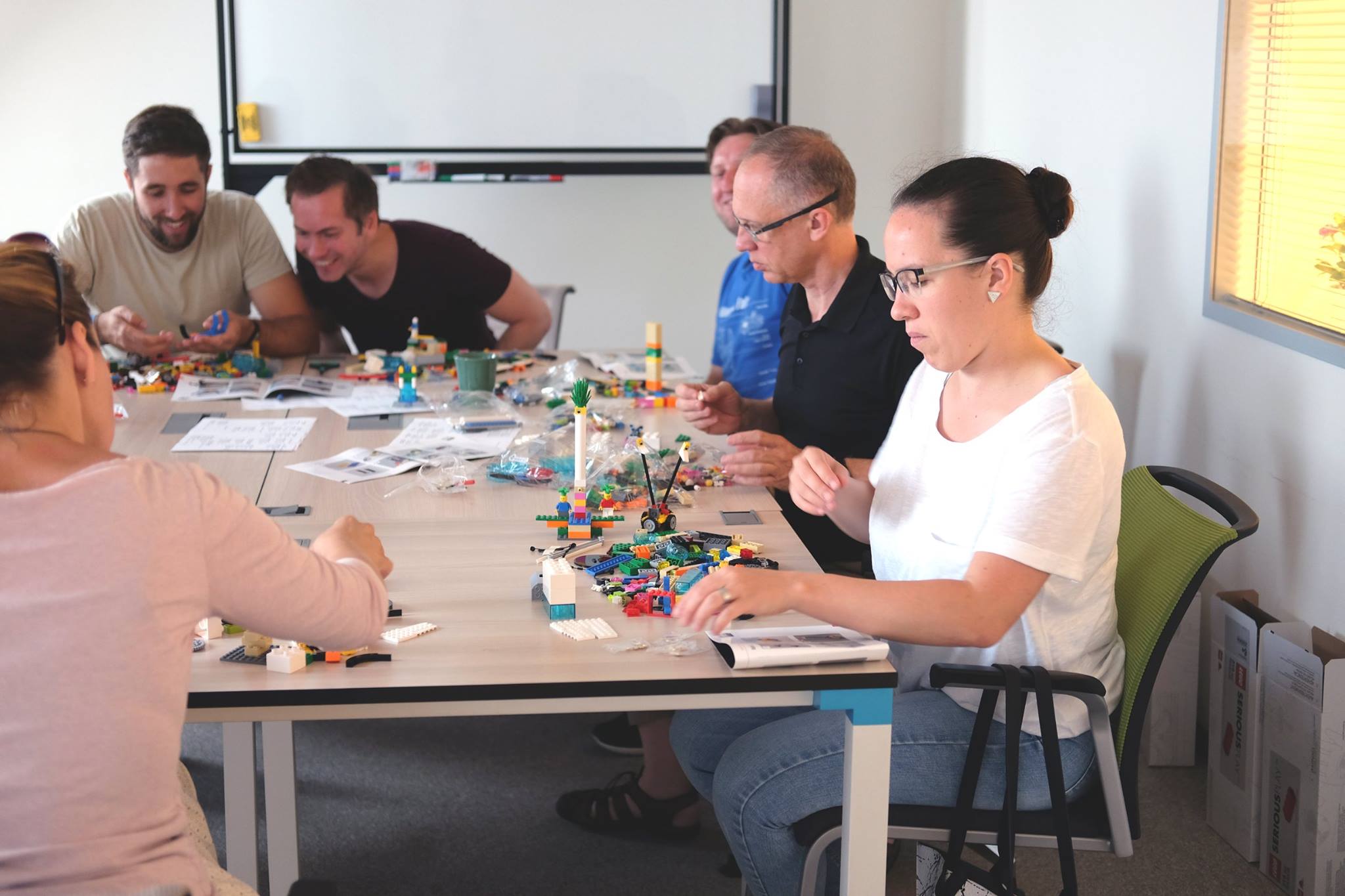
Download the canvases in pdf: Business model canvas1 (editable) and Business model canvas2.
For more information and ideas, see:
https://en.wikipedia.org/wiki/Business_Model_Canvas
https://www.alexandercowan.com/business-model-canvas-templates/
Zoltán Dévai is the other contributor of this article.

